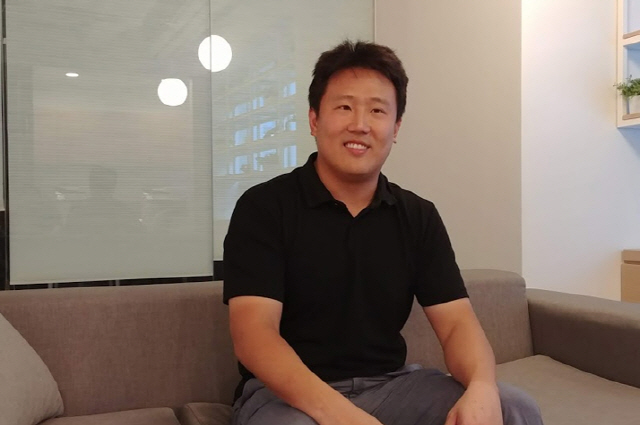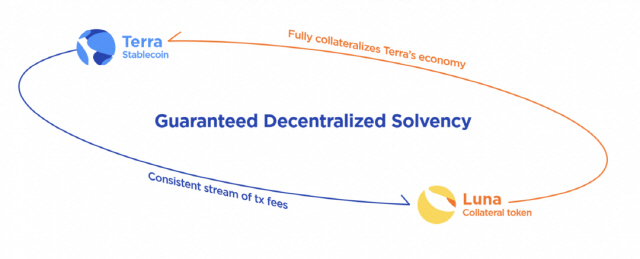
TMON (formerly Ticket Monster) founder Shin Hyun-sung has made a foray into the blockchain industry. The eyes of the business community are on the news that Shin, who founded Korea’s first e-commerce operator, has thrown his hat into the ring of blockchain. He set foot on the blockchain market with Terra, a global blockchain company that provides blockchain-powered payment solutions for e-commerce platforms. Terra has yet to unveil its finalized white paper but secured $32 million in its latest funding campaign. Monex Group, Passport Capital, HOF Capital and Kakao Ventures invested in its blockchain project.
In an interview in southern Seoul Sept. 20, Shin, who concurrently serves as Terra CEO, showed his strong determination in relation to his company’s entry into the blockchain industry, saying, “We aim to grow our cryptocurrency Terra as a global currency. We will nurture a cryptocurrency in which today’s value is identical to tomorrow’s and graft it to our real life.”
Terra, linked with existing legal tender, is a decentralized stable coin designed to prevent price volatility of cryptocurrencies. Cryptocurrency can be used in the real economy if its value remains stable and this prompted Shin to seek to lay the solid foundation for an innovative financial system ultimately. “We opted for a stable coin with an aim to create cryptocurrency having a universal exchange value with the belief that ordinary cryptocurrencies are inadequate in the real economy owing to their big price volatility,” he said, adding that “if cryptocurrencies are circulated through an alliance of e-commerce platforms where a customer base is clear, it will pave the way for blockchain to enter the real economy.”
The standard of currency value is not such legal tender as the won or the greenback but the International Monetary Fund’s Special Drawing Right (SDR) consisting of a few currencies. The SDR is a basket of currencies reflecting the relative importance of currencies to calculate the basic exchange rate in the international currency mechanism. Now Terra’s basket of currencies consists of dollar (41.73%), euro (30.93%), yuan (10.92%), yen (8.33%) and pound (8.09%). Terra has a value of about 1,500 won as it is linked with the SDR. So one needs 12 terras to buy roasted chicken worth 18,000 won from Baedal Minjok.
Why did Shin link Terra to the SDR, not the Korean currency won? According to him, the value of a stable coin could tumble together in accordance with price fluctuations of connected assets if Terra is tied up with specific currencies or assets, as is seen in the cases of tether linked with dollar and Maker DAO connected to Ethereum. “In the case of Maker DAO, in fact, its entire economy once lost 18% as a result of Ethereum’s crash,” Shin said. So it would be possible to reduce such risks as the SDR, a basket of currencies, determines the exchange rate according to the volatility of currency value.

Terra maintains its value by controlling the supply and demand through algorithm. Terra is backed by Luna, a decentralized token, to keep money in circulation and its value constant. The two tokens can be traded in exchanges.
The structure goes like this. If e-commerce platforms such as TMON and Baedal Minjok settle payments through Terra, the resultant transaction fees are allotted to Luna holders. As the use of Terra increases, resulting in the rise of dividend income, Luna’s value will go up too. Shin says his company plans to offer discounts if users pay through Terra on shopping platforms with which it partnered, in a move aimed at expanding the use of Terra. After all, all this is intended to push up Luna’s value naturally by making Terra’s buying attractiveness greater and raising its amount used.
The reason why Luna’s value is being pushed up is to utilize Luna when controlling the supply and demand of Terra. From the perspective of the supply and demand, Terra’s price goes up when demand increases. At this point, it’s necessary to lower Terra’s price by expanding the supply. The problem is when demand for Terra is falling. If Terra’s price comes down with the supply exceeding demand, the company must destroy Terra by absorbing coins in circulation. At this moment, the company needs money to buy Terra in circulation, and Luna the company holds is used to raise the fund. “We expect Luna’s value to go up some day. Luna will play the role of filling the needed money pool as both Terra and Luna economies go hand in hand together. This is based on the assumption that Luna’s combined value should exceed Terra’s.”
Another problem that must be solved before Terra becomes a global payment method is the speed. “We opted for a realistic method to solve the speed problem. We are considering ways to either upload payments in every bundle of 1,000 to a block or store them in the main chain all at once after recording them at a local database,” Shin said. He reacted negatively to the current method of recording every payment one by one.
Shin is also doubling down on securing platforms where Terra can be used actually. “Just as PayPal, ebay and Alipay thrived on partnerships with big e-commerce platforms like Taobao, Terra will pursue growth by teaming up with diverse platforms. We will become Alipay in the blockchain industry,” he explained.
Terra has already been collaborating with Asia’s leading e-commerce platforms. Aside from TMON, it formed partnerships with Baedal Minjok and Asia’s 15 companies, including Qoo10, a global shopping platform; Carousell, Southeast Asia’s largest online marketplace for secondhand goods; and Tiki, one of Vietnam’s leading e-commerce platforms. The “Terra Alliance” is expanding rapidly with the steady rise of its partners. Currently, Terra boasts a customer base of 40 million with an annual turnover of $25 billion.
Customers to the Terra Alliance get discounts and rewards through Terra-mediated payments. Its partners are subject to much lower transaction fees than Visa Card and other payment service providers offer. “Customers may save on 20 to 30% of transaction fees if they pay via Terrapay,” Shin said.
Shin said he benefited much from his experiences with TMON in going ahead with the Terra project. “After all, publicizing Terra is conducted through e-commerce platforms. My relationships with them when I had worked for TMON helped build the Terra Alliance greatly,” he said.
Terra’s ultimate goal is to be a financial platform that covers all types of financial products including lending and insurance, beyond e-commerce. That is, Terra is seeking to leap over the currency and evolve into an open protocol. “Terra will play the role of a real digital currency 10 years later. We ultimately aim to nurture Terra as a blockchain fintech solution used by all blockchain DApps,” he said confidently.
The beta testing for the Terra payment system is scheduled for the fourth quarter of this year.
/Eundong Shin Reporter edshin@decenter.kr
- Eundong Shin Reporter








![비트코인 8만 8000달러선…주요 알트코인도 하락세[디센터 시황]](https://newsimg.sedaily.com/2025/12/15/2H1QMJVFUE_2_s.png)




![[단독]네이버파이낸셜, 해시드와 ‘코인 지갑’ 내달 선보인다](https://newsimg.sedaily.com/2025/11/25/2H0LB3A07Q_11_s.jpg)
![[단독]금융위 “공동검사 요구 과도”…스테이블코인 놓고 한은과 파열음](https://newsimg.sedaily.com/2025/11/24/2H0KUTU6OA_5_s.png)
![[단독] '은둔의 경영자' 송치형, 네이버와 합병 청사진 직접 밝힌다](https://newsimg.sedaily.com/2025/11/21/2H0JI570IZ_5_s.jpeg)








